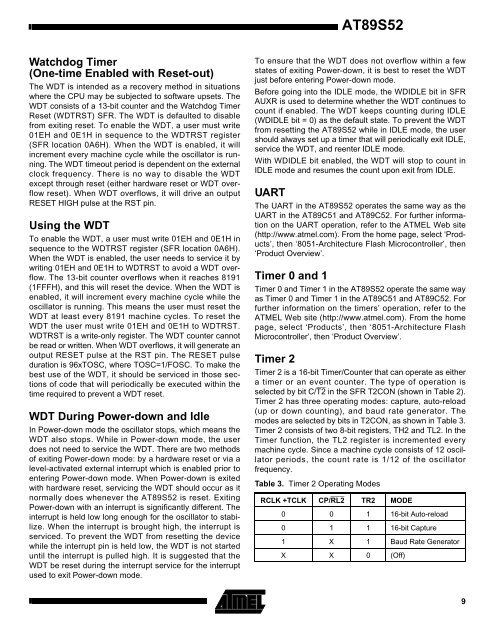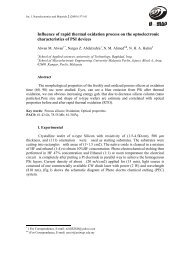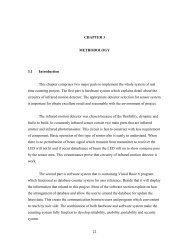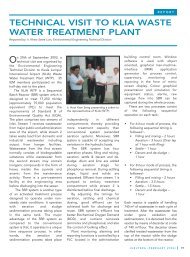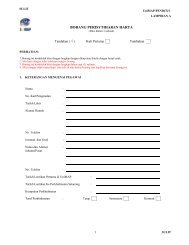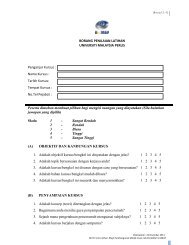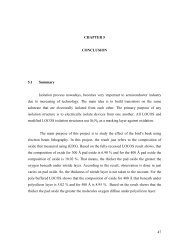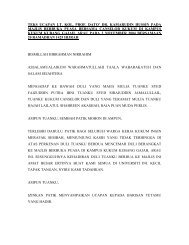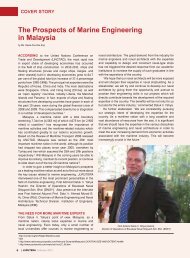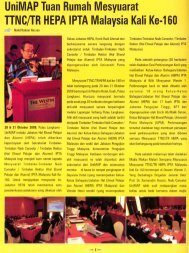CHAPTER 3 METHODOLOGY 3.1 Overview The Water Monitoring ...
CHAPTER 3 METHODOLOGY 3.1 Overview The Water Monitoring ...
CHAPTER 3 METHODOLOGY 3.1 Overview The Water Monitoring ...
You also want an ePaper? Increase the reach of your titles
YUMPU automatically turns print PDFs into web optimized ePapers that Google loves.
AT89S52Watchdog Timer(One-time Enabled with Reset-out)<strong>The</strong> WDT is intended as a recovery method in situationswhere the CPU may be subjected to software upsets. <strong>The</strong>WDT consists of a 13-bit counter and the Watchdog TimerReset (WDTRST) SFR. <strong>The</strong> WDT is defaulted to disablefrom exiting reset. To enable the WDT, a user must write01EH and 0E1H in sequence to the WDTRST register(SFR location 0A6H). When the WDT is enabled, it willincrement every machine cycle while the oscillator is running.<strong>The</strong> WDT timeout period is dependent on the externalclock frequency. <strong>The</strong>re is no way to disable the WDTexcept through reset (either hardware reset or WDT overflowreset). When WDT overflows, it will drive an outputRESET HIGH pulse at the RST pin.Using the WDTTo enable the WDT, a user must write 01EH and 0E1H insequence to the WDTRST register (SFR location 0A6H).When the WDT is enabled, the user needs to service it bywriting 01EH and 0E1H to WDTRST to avoid a WDT overflow.<strong>The</strong> 13-bit counter overflows when it reaches 8191(1FFFH), and this will reset the device. When the WDT isenabled, it will increment every machine cycle while theoscillator is running. This means the user must reset theWDT at least every 8191 machine cycles. To reset theWDT the user must write 01EH and 0E1H to WDTRST.WDTRST is a write-only register. <strong>The</strong> WDT counter cannotbe read or written. When WDT overflows, it will generate anoutput RESET pulse at the RST pin. <strong>The</strong> RESET pulseduration is 96xTOSC, where TOSC=1/FOSC. To make thebest use of the WDT, it should be serviced in those sectionsof code that will periodically be executed within thetime required to prevent a WDT reset.WDT During Power-down and IdleIn Power-down mode the oscillator stops, which means theWDT also stops. While in Power-down mode, the userdoes not need to service the WDT. <strong>The</strong>re are two methodsof exiting Power-down mode: by a hardware reset or via alevel-activated external interrupt which is enabled prior toentering Power-down mode. When Power-down is exitedwith hardware reset, servicing the WDT should occur as itnormally does whenever the AT89S52 is reset. ExitingPower-down with an interrupt is significantly different. <strong>The</strong>interrupt is held low long enough for the oscillator to stabilize.When the interrupt is brought high, the interrupt isserviced. To prevent the WDT from resetting the devicewhile the interrupt pin is held low, the WDT is not starteduntil the interrupt is pulled high. It is suggested that theWDT be reset during the interrupt service for the interruptused to exit Power-down mode.To ensure that the WDT does not overflow within a fewstates of exiting Power-down, it is best to reset the WDTjust before entering Power-down mode.Before going into the IDLE mode, the WDIDLE bit in SFRAUXR is used to determine whether the WDT continues tocount if enabled. <strong>The</strong> WDT keeps counting during IDLE(WDIDLE bit = 0) as the default state. To prevent the WDTfrom resetting the AT89S52 while in IDLE mode, the usershould always set up a timer that will periodically exit IDLE,service the WDT, and reenter IDLE mode.With WDIDLE bit enabled, the WDT will stop to count inIDLE mode and resumes the count upon exit from IDLE.UART<strong>The</strong> UART in the AT89S52 operates the same way as theUART in the AT89C51 and AT89C52. For further informationon the UART operation, refer to the ATMEL Web site(http://www.atmel.com). From the home page, select ‘Products’,then ‘8051-Architecture Flash Microcontroller’, then‘Product <strong>Overview</strong>’.Timer 0 and 1Timer 0 and Timer 1 in the AT89S52 operate the same wayas Timer 0 and Timer 1 in the AT89C51 and AT89C52. Forfurther information on the timers’ operation, refer to theATMEL Web site (http://www.atmel.com). From the homepage, select ‘Products’, then ‘8051-Architecture FlashMicrocontroller’, then ‘Product <strong>Overview</strong>’.Timer 2Timer 2 is a 16-bit Timer/Counter that can operate as eithera timer or an event counter. <strong>The</strong> type of operation isselected by bit C/T2 in the SFR T2CON (shown in Table 2).Timer 2 has three operating modes: capture, auto-reload(up or down counting), and baud rate generator. <strong>The</strong>modes are selected by bits in T2CON, as shown in Table 3.Timer 2 consists of two 8-bit registers, TH2 and TL2. In theTimer function, the TL2 register is incremented everymachine cycle. Since a machine cycle consists of 12 oscillatorperiods, the count rate is 1/12 of the oscillatorfrequency.Table 3. Timer 2 Operating ModesRCLK +TCLK CP/RL2 TR2 MODE0 0 1 16-bit Auto-reload0 1 1 16-bit Capture1 X 1 Baud Rate GeneratorX X 0 (Off)9


